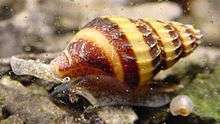Clea (gastropod)
| Clea | |
|---|---|
 | |
| A live individual of Clea helena | |
 | |
| A live individual of Clea helena | |
| Scientific classification | |
| Kingdom: | Animalia |
| Phylum: | Mollusca |
| Class: | Gastropoda |
| (unranked): | clade Caenogastropoda clade Hypsogastropoda |
| Superfamily: | Buccinoidea |
| Family: | Buccinidae |
| Genus: | Clea A. Adams, 1855[1] |
| Synonyms | |
| |
Clea is a genus of freshwater snails with opercula, aquatic gastropod mollusks in the family Buccinidae, the true whelks, a large family, almost all of the rest of which are marine.[2][3]
Species
Species within the genus Clea include:[4]
- Clea annesleyi Benson, 1861
- Clea bangueyensis Smith, 1895
- Clea bizonata (Deshayes, 1876)
- Clea bockii Brot, 1881
- Clea bocourti (Brot, 1876)
- Clea broti Deshayes, 1876
- Clea cambojiensis (Reeve, 1861)
- Clea funesta H. Adams, 1862
- Clea fusca (H. Adams, 1862)
- Clea helena (Meder in Philippi, 1847)
- Clea hidalgoi (Crosse, 1886)
- Clea jullieni (Deshayes in Deshayes & Jullien, 1876)
- Clea nigricans A. Adams, 1855
- Clea paviei Morlet, 1866
- Clea scalarina (Deshayes in Deshayes & Jullien, 1876)
- Clea spinosa Temcharoen, 1971
- Clea wykoffi Brandt, 1974
Distribution
This genus occurs in Asia and Africa.[5]
Feeding habits
Like all snails in the clade Neogastropoda, snails in this genus are carnivorous.[3]
References
- ↑ Adams A. (1855); Description of two new genera and several new species of Mollusca, from the collection of Hugh Cuming, Esq. Proceedings of the Zoological Society of London, 23: 119-124
- ↑ Bouchet, P.; Fraussen, K. (2013). "Clea – H. Adams & A. Adams, 1855". World Register of Marine Species. Retrieved 2 March 2014.
- 1 2 Monks, Neale (2009). "Assassin Snails and Sulawesi Elephant Snails: Keeping Clea and Tylomelania in the aquarium". Conscientious Aquarist Magazine. Retrieved March 11, 2014.
Clea are whelks, most of which live in the sea. Like their marine relatives, Clea are opportunistic carnivores that feed on both live prey and carrion. Among the prey taken are snails, and it is this that has made them popular with fishkeepers. Clea stay partially hidden under the sediment, and if a snail slides past, then quickly (by snail standards) jump into action, chasing their prey and eventually subduing it.
- ↑ Roskov, Y.; Kunze, T.; Orrell, T.; Abucay, L.; Paglinawan, L.; Culham, A.; Bailly, N.; Kirk, P.; Bourgoin, T.; Baillargeon, G.; Decock, W.; De Wever, A.; Didžiulis, V., eds. (26 February 2014). "Search all names – Results for Clea". Species 2000 & ITIS Catalogue of Life. Retrieved 4 March 2014.
- ↑ Monks, Neale. "Clea helena, formerly known as Anentome helena". Retrieved 4 March 2014.
This article is issued from Wikipedia - version of the 9/10/2016. The text is available under the Creative Commons Attribution/Share Alike but additional terms may apply for the media files.